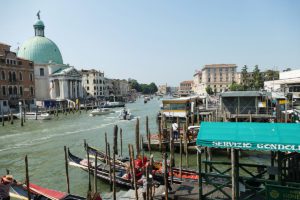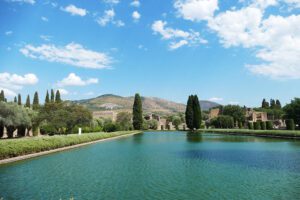To get away from the weekend’s hustle and bustle, a day trip from Venice to Padua is just the perfect escape.

There’s a lot to see – and the train takes you there in only 14 minutes.
Although Padua is an orphan compared to glamorous, mysterious Venezia, it’s absolutely underrated. Of course, there aren’t those fantastic palazzi at every corner, it’s the real world, after all.
But there are a couple of nice spots and buildings absolutely worth the visit once you’re tired of this constant pushing and shoving of masses of tourists.
Sorry, Wrong Funeral
Coming from the main station, my first steps led me to the Scrovegni Chapel to see the famous Giotto frescos.
As I got there, a funeral service just had ended. There was the family and other mourners standing in small groups in front of the church, whispering and sobbing into embroidered handkerchiefs. Next to them stood the undertaker’s car, the coffin halfway in.
Amazing that this world-famous landmark was still used for services, I thought to myself. However, I was a bit irritated as inside, I couldn’t make out any Giotto frescos. Actually, there were hardly any decorations at this house of worship.
Then it dawned on me: I was in the wrong church. Although I had a map that clearly showed the location of the Scrovegni Chapel, I was convinced I had arrived as soon as I had spotted a church.
So I lingered for a couple more minutes. Somehow, this made me feel less a fool – as if I really had a personal matter to tend to at that very church. Then I left – trying to maintain a very low profile.
Fortunately, the mourners were busy mourning. Those who had seen me might have thought I was the deceased’s, secret mistress.
Padua
As a matter of fact, Padua is one of the oldest cities in Italy. It lies on the edge of the Po Valley, about 30 kilometers west of Venice. According to legend, it was founded by the Trojan Antenor around 1184 B. C. In the 4th century B. C., a fishing village was built alongside the Bacchiglione river and the region quickly gained great importance for the Venetians.
Dating back to Roman times, there are still some of the oldest segmental arch bridges in the world In the old town of Padua.
In 779, Charlemagne brought Padua under Frankish rule. The city was later assigned to the Holy Roman Empire. In 1222, the University of Padua was founded as the third university in Italy, after Bologna and Modena. Also, some of the most important Italian artists worked and lived in Padua, the most famous one is probably Giotto di Bondone.

With the decline of the powerful Carraresi family, its members were the Lords of Padua from 1318 to 1405, the city also lost its political independence and came under the rule of Venice. This by no means hindered cultural development. After all, Donatello and Andrea Mantegna, among others, worked in Padua until the first half of the 15th century.
Biding Farewell to Venice
The Venetian hegemony ended at the end of the 18th century when Padua was occupied by the French and ceded to Austria in the Peace of Campo Formio in 1797. Only eight years later, Padua became part of the Kingdom of Italy founded by Napoleon Bonaparte in the Peace of Pressburg. In 1814, Padua basically was returned to Austria as part of the Kingdom of Lombardy-Venetia. Austria’s Emperor was the King of both realms.
However, Padua’s industrial development was ignited under the Habsburg rule. In 1845, the Padua-Venice line was constructed as one of the first railway lines in all of Italy.
Yet, with the Peace of Vienna, Padua and Venice definitely became part of the Kingdom of Italy in 1866.
Although Padua is thriving in the big shadow of glorious Venice, it has two entries on the Unesco World Heritage List. On the one hand, due to its fantastic botanical garden, but also because of several amazing frescos which were created in the 14th century. The most famous one is definitely the Scrovegni Chapel which was richly decorated by Giotto di Bondone.
Getting to Know Padua in One Day
Padua is a beautiful small city, and due to the important university, it has a very cool and relaxed vibe. As you walk around, you won’t see as many great palazzi as in Venice and there are hardly any canals here. But you’ll see cute little shops, have coffee or gelato at a cozy little place with tables and chairs right on the sidewalk, and immerse in real Italian life.

Padua does not give off that museum vibe that many of those mesmerizing Italian cities have. However, while the city breathes Padua authenticity, there definitely is a grand cultural heritage, and below, I’m introducing some of the most important landmarks you can visit – even if you’re visiting only for one day.
Basilica di Sant’Antonio
The most famous structure is the Basilica di Sant’Antonio. As a matter of fact, it is one of the most famous and most visited sanctuaries in all of Italy. The foundation stone of the first part of the basilica was laid in 1232 shortly after the death of Saint Anthony of Padua.

In Antonio’s time, on the site of today’s church was a small chapel dedicated to Maria Mater Domini. Next to this chapel, a monastery was built in 1229.
The basilica’s eight domes are similar to the 5-domed structure of St. Mark’s Basilica in Venice. Its two slender hexagonal high bell towers and two minaret-like turrets are typical features of the Byzantine architectural style.
Amazing Chapels
In contrast, the interior of the basilica has Gothic and Romanesque elements. Donatello’s masterpieces decorate the sanctuary.

The remarkable chapel of St. James in the right transept is one of the main works of the 14th century in Italy due to its architecture and its magnificent frescoes.

At the Arc of the Saint, there’s not only Antonio’s tomb. There are also other relics on display like his tongue and his vocal cords. I even saw some dentures. At least for non-Catholics, this is a bit creepy.
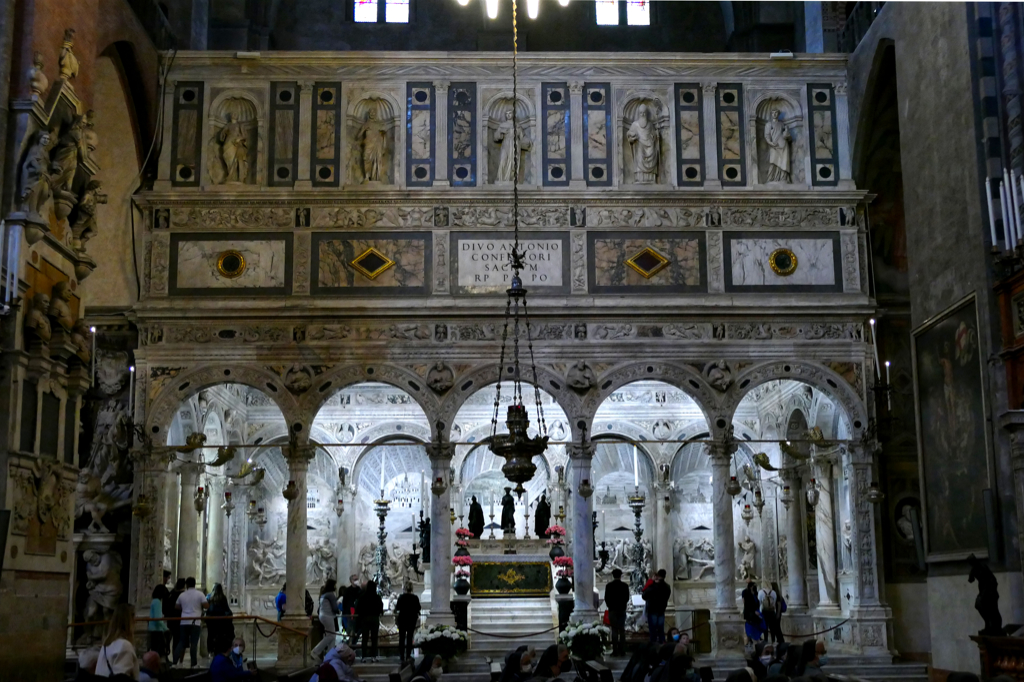
Make sure to take a good look around the Piazza del Santo. Left of the basilica stands a bronze equestrian statue of the Venetian general Erasmo da Narni. This so-called Gattamelata was also created by Donatello.
Basilica di Sant’Antonio
Piazza del Santo 11
35123 Padua
The basilica can be visited every day between 6.15 a. m. and 7.30 p. m. free of charge.
Prato della Valle
Just a short walk south of the basilica is the Prato della Valle. After the Red Square in Moscow and the Place de la Concorde in Paris, it is Europe’s third-largest inner-city square. However, it is by no means square, but elegantly rounded and decorated with 78 statues. 38 of them are standing in the inner ring and 40 in the outer ring. Also, it is surrounded by a canal, so you reach the center over bridges.

I’m sure it must be awe-inspiring seeing the entire 90.000 square meters of the elliptical square. However, I never really had the chance to see the Prato in its entirety since there is always something view-obstructing going on.

East of the Prato is Padua’s famous Orto Botanico, the botanical garden. It was founded in 1545 and is considered the oldest surviving university botanical garden. No less than the great German poet Goethe studied leaf growth here on a palm tree planted in 1585. It can still be seen today – the tree, not the poet, though. Also, the Orto Botanico made it onto the list of Unesco World Heritage Sites.
It is open every day from 10 a. m. to 7 p. m. and can be visited for an entrance fee of 10 €uros. Visitors under 26 pay half price.
Abbazia di Santa Giustina
South of the Prato della Valle rises the Abbazia di Santa Giustina. A Benedictine abbey was founded near the church probably in the 10th century. A Romanesque new building for the abbey church was built in the early 12th century which was later expanded.
At the end of the 16th century, the old buildings were demolished and replaced by the current Renaissance complex with five cloisters. Only the chapel with the remains of San Luca and the old choir have been preserved.
I find that all the church buildings in Padua look pretty monumental – already due to the fact that they have these brick façades and not one high tower but a couple of bulky ones. Hence, their dominant architecture reminds me a bit of the Hagia Sofia in Istanbul. The Abbey of Santa Giustina is no exception – and is said to be the most important building in Padua because of its architecture.

It is one of the largest churches in the world. The almost five-aisled basilica has the floor plan of a Latin cross. It’s covered by eight domes, four large and four small ones. A copper statue of St. Justina, the patron saint of Padua, stands on the middle highest tambour dome. Inside, she’s depicted in a painting by Paolo Veronese at the high altar.
Abbazia di Santa Giustina
Via G. Ferrari 2/A
35123 Padua
The Abbazia is open every day from 7.30 a. m. till noon and in the afternoon from 3 p. m. till 6 p. m. and can be visited free of charge.
Palazzo Bo
In the first decades of the 16th century, the university’s different faculties were united in the complex of buildings known as Palazzo Bo. This name derives from the famous Hospitium Bovis, which means ox hostel in Latin. It won’t surprise you that in former times, the old street of butchers was located in the vicinity. However, already at the end of the 13th century, the city’s wealthy patriciate commissioned townhouses in this area.
The remodeling for the university use began way back in 1493 and was completed only at the beginning of the 17th century. The entire building, including the modern courtyard, was refurbished between 1938 and 1942. The famous architect Gio Ponti was in charge of furnishing and decoration.

Elena Lucrezia Cornaro Piscopia obtained a degree in philosophy from the university in 1678. This made her the world’s first female graduate.
Today, the Teatro Anatomico, the Aula Magna, and Galileo’s pulpit can be visited on guided tours. He taught at Padua’s university between 1592 and 1610.
Palazzo Bo
Via VIII Febbraio 2
35122 Padua
From Monday to Friday, you can join the tour Palazzo Bo historic tour in English at noon and at 4.30 p.m. The tours at 11 a. m., 3.30 p. m., and 5.30 p. m. are in Italian. A general ticket costs 7 €uros.
The more specialized tour themed Palazzo Bo and the ‘900 of Gio Ponti takes place on Saturdays and Sundays at 9.30 a. m., 11 a. m. 2 p. m., 3.30 p. m., and 5 p. m. in Italian. The only tour in English takes place at 12.30 p. m. These tours cost 12 €uros.
Palazzo Moroni
The Palazzo Moroni, is an imposing building complex made up of various palazzi from different eras. These venerable structured have housed the municipal administration since the 13th century. The famous Palazzo della Ragione, as well as the Torre degli Anziani, are part of the complex.

The complex connects the Piazza delle Erbe and the Piazza della Frutta and functions as Padua’s town hall today.
Palazzo Moroni
Via del Municipio 1
35122 Padua
Cathedral of Santa Maria Assunta
The construction of today’s cathedral began in 1522. After a tender in 1551, the commissioners decided on a design by Michelangelo Buonarroti. It was slightly modified and finally implemented in 1582.
From 1635 onwards, the other parts of the ancient cathedral were gradually demolished to be replaced by modern elements. In 1754, the work was stopped so that the façade remained unfinished.

In 1997, the choir room was redesigned and decorated with unique statues by contemporary sculptor Giuliano Vangi from Florence.
Very impressive is the Baptistery, located to the right of the cathedral. Built in the 12th century, it is embellished with frescoes by Giusto de Menabuoi.
Cathedral Santa Maria Assunta
Piazza Duomo
35139 Padua
The cathedral is open every day from 8 a. m. till noon and in the afternoon from 3 p. m. to 7.30 p. m.
Museo Diocesano And Palazzo Vescovile
On the opposite side from the Baptistery is the Palazzo Vescovile, the Bishop’s palace. It houses the diocesan museum and can thusly be visited, although the Bishop actually lives on the second floor.

On the first floor, precious handwritten books from the different centuries can be admired. On the upper floor, you’ll find some truly fine art. Especially the beautifully painted lounge is worth a visit.

Museo Diocesano di Padova – Palazzo Vescovile
Piazza Duomo 12
35141 Padua
For a general admission fee of 9 €uros, you can visit the museum Mondays from 1.30 p. m. to 6 p. m. and from Tuesday to Sunday from 10 p. m. till 1.30 p. m. and then again in the afternoon between 2 p. m. and 6 p. m.
Palazzo della Ragione
The Palazzo della Ragione, also known as the Salone, is one of Padua’s most significant landmarks. Built between 1172 and 1219, it is embellished with beautiful allegoric frescos.

The upper floor is occupied by the former council and courtroom decorated with frescoes (World Heritage Site), the actual “Salone”, which is spanned by a wooden roof construction resembling a ship’s keel.

It is actually part of the Palazzo Moroni complex and functioned as a court until the end of the 18th century.
At one end of the humongous hall is a black wooden horse. Based on its resemblance to the horse of the statue del Gattamelata at the Piazza del Santo, Giorgio Vasari attributed it to Donatello. At the other end of the Salone is a big Faucault pendulum.
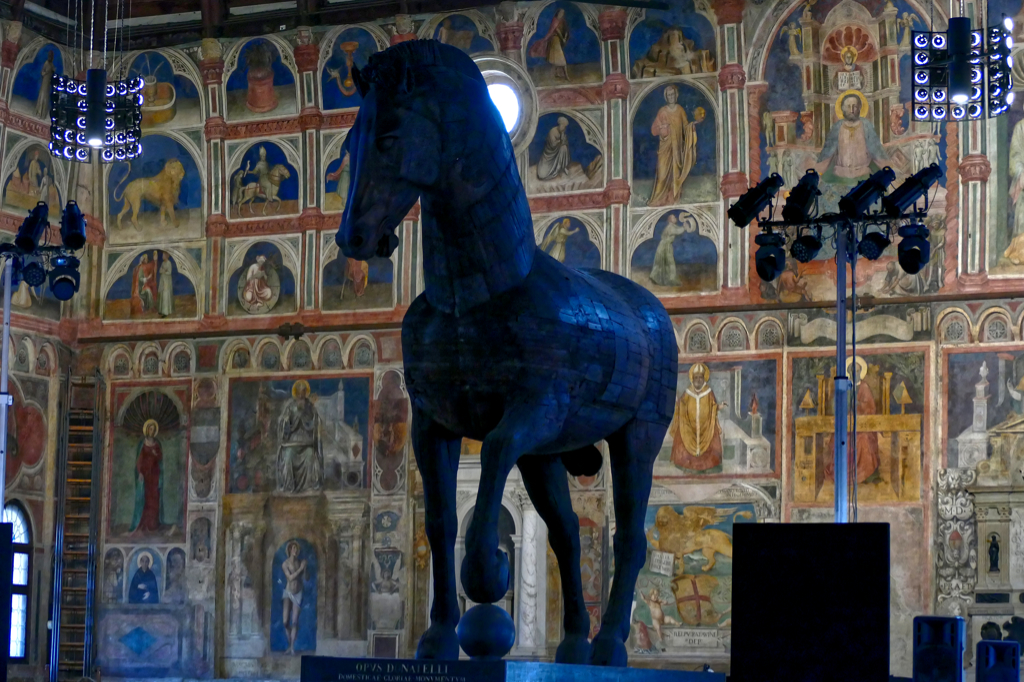
Palazzo della Ragione
Piazza delle Erbe
35100 Padua
A visit to the Palazzo della Ragione should definitely be on your itinerary when coming to Padua. It is open from Tuesday to Sunday between 9 a. m. and 6.30 p. m. The general admission fee is 7 €uros.
Palazzo Zuckermann
The Palazzo Zuckermann is an imposing building, located on Corso Garibaldi close to the Musei Civici Eremitani.
Today, it houses the Museum of Applied Arts on the ground floor and first floor. The collection consists of more than two thousand works of artistic craftsmanship such as collections of ceramics, furnishings, clothing, accessories, and jewelry. It ranges from the Middle Ages to contemporary.
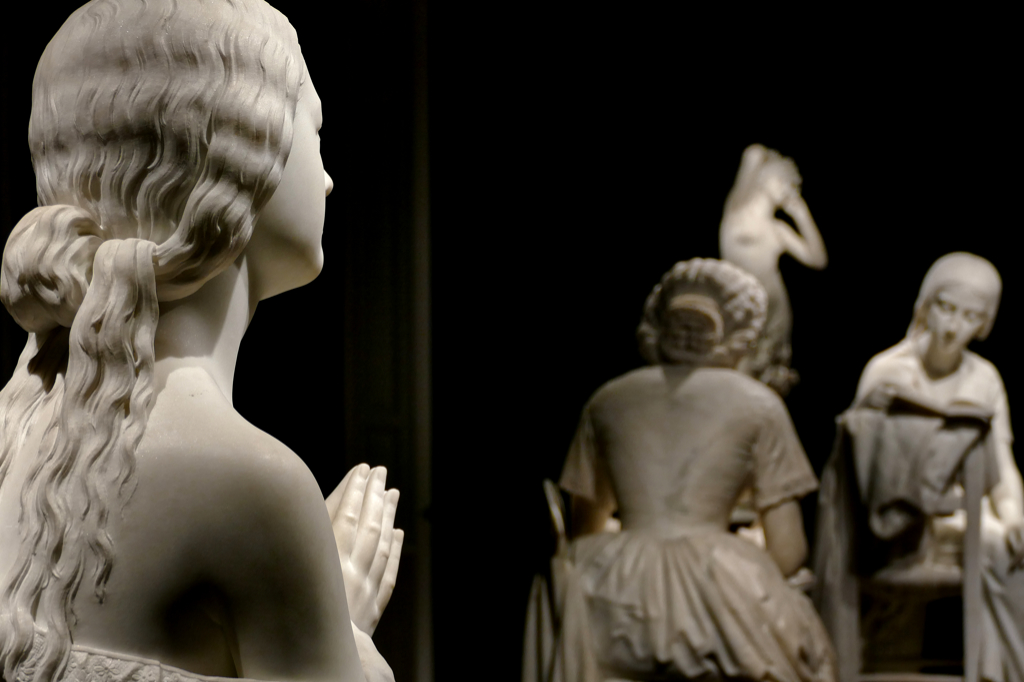
On the second floor is the so-called Bottacin Museum. It houses the collections donated in 1865 by the numismatist Nicola Bottacin. Here, Greek coins, Roman and Byzantine coins, and medallions are on display. There are also paintings and sculptures that I actually liked the most.

The most valuable piece is probably the Bust of Doge Paolo Renier by Antonio Canova.
Palazzo Zuckermann
Corso Giuseppe Garibaldi 33
35122 Padua
The museums are open from Tuesday to Sunday between 10 a. m. and 7 p. m. The general admission is 10 €uros, however, a visit is included in the ticket to the Scrovegni Chapel and the Musei Civici Eremitani.
Chiesa degli Eremitani
Right next to the Musei Civici Eremitani is the Chiesa degli Eremitani, a church of the Augustinian hermits from the 13th century. Martin Luther stayed in the monastery on his trip to Rome in 1510.

The church is famous for its amazing frescoes by Guariento di Arpo and Andrea Mantegna who was only 17 years old when he painted these masterpieces.

Sadly, they fell victim to an Allied bombing raid during WWII in 1944. Only 77 square meters of the originally several 100 square meters were saved. Albeit, in the shape of 88,000 small fragments. Those were later assembled to reconstruct the work with the help of mathematicians.
Chiesa degli Eremitani
Piazza Eremitani 9
35129 Padua
The church is open from Monday to Friday between 7.30 a. m. and 12.30 p. m. and in the afternoon from 3.30 p. m. till 7 p. m. On weekends, it’s open in the morning from 9 a. m. till 12.30 p. m. and in the afternoon from 4 p. m. till 7 p.m. The visit is free of charge.
Musei Civici Eremitani
The Musei Civici is actually a small group of museums and historic sites. It is centered on the former convent of the Eremitani. Its most precious part is the Cappella degli Scrovegni, obviously.
The collection is based on the purchase of works from concealed religious institutions. It was then extended by various donations.

At the Pinacoteca, you can admire paintings by Jacopo Bellini, Paolo Veronese, and Tintoretto. However, you’ll also get a foretaste of your visit to the Scrovegni Chapel as well as the Church of the Eremitani since there are also paintings by Giotto and Andrea Mantegna on display.

On the premises is also a beautiful sculpture garden that you can visit free of charge.
Musei Civici Eremitani
Piazza Eremitani 8
35121 Padua
While the museum complex is open from Tuesday to Sunday from 9 a. m. to 7 p. m., the Scrovegni Chapel is open every day. Tickets for visits from Tuesday to Sunday cost 14 €uros and include the admission to the Musei Civici degli Eremitani and to the Palazzo Zuckermann. On Monday, as you can visit only the Chapel, the tickets cost only 10 €uros.
You need a reservation for a time slot since only about 20 people are allowed in at a time. Especially during the high season, you should make your online reservation* at least a couple of days ahead since tickets tend to sell out fast.
Scrovegni Chapel
In 1300, Enrico Scrovegni, a wealthy Paduan banker, merchant, and nobleman, bought the dilapidated Roman amphitheater on the outskirts of the city. Here, he commissioned a now-ruined family palace as well as a chapel in memory of his father.

Scrovegni designated well-known artists of his time to decorate the single-nave interior of the chapel. Giovanni Pisano made around 1305-1306 three marble statues for the altar, the Virgin Mary with Child, and two angels holding candlesticks. From 1304 to 1306, Giotto di Bondone painted the walls and vault of the chapel with 38 scenes from the life of Saints Joachim and Anne, their daughter Mary and the life of Jesus Christ.

The time slots of the visits are about 20 minutes. They start with an informative video on the chapel. Then they let the small group of about 20 people in. This is a very smart procedure since the chapel is really small and just mesmerizing. Therefore, lots of people at the same time would not only harm this masterpiece but also spoil the special atmosphere for the visitors.

After all, I was very happy to have had such a late time slot since the visit was so impressive, I wouldn’t have liked to visit other sights after this, which I’ve found much more touching than for instance the Cenacolo by da Vinci in Milan.
You’ll find all the info on how to visit the Chapel in the section on the Musei Civici Eremitani since those two landmarks are connected. However, I’d like to emphasize again that especially during the high season, you should make your online reservation* at least a couple of days ahead to avoid disappointments.
Special Treat: To Padua Alongside the Summer Villas on the River Brenta
By the way, you can also get to Padua from Venice in stages. Along the river Brenta are some of the finest summer villas of the Venetian nobles. Yes, these good people needed a break from all the wealth and beauty in Venice from time to time, so they escaped – to the wealth and beauty along the Brenta.
To meander on the river, you can book a tour*. However, you can also go by bus which is cheaper but much less charming, obviously. Also, it needs some thorough planning, since the buses don’t go that often.
When I took the bus, I made a list of the villas I wanted to see and then bought all my bus tickets accordingly beforehand at the bus terminal in Venice.
My last stop then was Padua from where I took the train back to Venice.
Practical Information
How To Get There
Flight
If you’re coming to Padua by plane, you land at the Marco Polo airport in Venice. Although this is about 50 kilometers east of Padua, you can continue your trip to the city in an easy and cheap way.

The most convenient option is the Busitalia Veneto, a bus that takes you to Padua for 8.50 €uros in about one hour. Mind you, if you buy your ticket from the driver, it costs 10 €uros.
Unfortunately, the bus goes only more or less every hour. If you don’t want to wait, a great alternative is to take bus #15 to the Mestre railway station. From there, you can take a train to Padua. However, check the prices and the length of the different train rides on Trenitalia’s website since prices vary from about 4 €uros to almost 20 €uros depending on the type of the train. Also, the trip can take from less than 20 minutes to about 45 minutes – and yet, that does have nothing to do with the fare you’re paying. There are rides that take 14 minutes and cost 3.70 €uros and rides that take 16 minutes and cost 19 €uros – just because the first one is a regional train.
Obviously, there is also a car rental service at the airport, and you can always take a cab. In my opinion, it’s a waste of money since the system of public transportation is really great.
Train
Coming from other Italian cities or neighboring European countries, you’ll probably get to Padua by train. Despite all complaints from frequent travellers, Trenitalia, Italy’s national railway company, offers a really good service at very reasonable prices. However, especially on weekends, trains tend to be very full, particularly the regional ones. The only recommendation I’d like to give you is to make a reservation in advance where possible. And to travel as light as you can to be more comfortable.
So if you are an environment-friendly traveller or on a railroad trip across Europe, Padua can be quickly and easily reached for instance from Vienna, Munich, Ljubljana, and even Zurich in about 6 hours. From Vienna, you can even take a sleeper train to Venice from where you then get to Padua in a couple of minutes.
The Times They Are A-Changin’
Do you remember those days when you had to validate your ticket before boarding the train? I’ll never forget a trip from Venice when I realized about 90 seconds before departure that I hadn’t validated my ticket. Now I had the choice between racing to the machine on the platform and risking the train leaving without me. Or staying on the train with an invalidated ticket and risking the controller fine me.
What did I do? Well, with my heart pounding like crazy, I ran to the machine, had almost a heart attack when the train made this exhaling sound as if it was about to leave, yelled noooo, stamped the ticket, ran back, hopped on the train – off we went.

Well, good news: Those days are over – at least when you buy your ticket online which I highly recommend. Not only can you check in e.g. validate your ticket comfortably on your phone. You can also alter your booking before you check in!
That’s such a great service: You go online, choose your connection, and pay. Then you’ll get an email reminding you that your ticket isn’t valid until you check in online. This is a very easy process including two clicks.
However, you shouldn’t too early because until you’re checked in, you can change your ticket free of charge. Been there, done that, worked like a charm.
Therefore, I’d recommend checking in only as you get to the train station.
Bus
Flixbus is conquering the world – at least the world’s European part, hence it’s also serving Padua. It might not be the fastest way to travel, but it’s quite comfortable and definitely the cheapest. For instance from Munich, a one-way trip sets you back around 40 €uros and takes about 7.5 hours. Tickets from Vienna are around 38 €uros and the trip takes around 9 hours. From Rome, it’s about 6 hours and tickets start at around 15 €uros.
The Flixbus stops in Padua is located on Via Fra’ Paolo Sarpi 42, a couple of minutes west of the main train station.
To check schedules and prices, visit their website.
How to Get Around
The city center of Padua is not that big and can be comfortably explored by walking. However, there is a good network of public buses.
Tickets can be purchased from vending machines and at many authorized points such as tobacco shops. A single ride costs 1.30 €uros, however, keep in mind that if you buy your ticket from the driver, you’ll have to pay 2.50 €uros. There is also a day pass for 3.60 €uros.
A travel planner offered by the local company Busitalia Veneto is a great tool for planning your rides. It is available on their website. Alternatively, Google maps is a valid alternative – just type in your position and your destination and it shows you the best connection.
The best way to explore Padua is probably by bicycle, obviously. You can easily use the wonderful E-bikes by downloading the free Ridemovi app from the App Store or Google Play.
As you ride the bike around the city, you do have not to bring the bike back to the stations. The bikes are equipped with GPS, a sim card, and a smart lock that can be locked and unlocked using the Ridemovi App.

The basic fare for a single ride is 1 €uro for the first 20 minutes of travel and then € 1.00 every 20 minutes. Consequently, a subscription for a 30-day pass might pay out quite quickly since it costs only 9.99 €uros.
Where to Stay
If you plan to spend the night in Padua, you have many options – from budget to luxury. Here are some good options for where to say*:
Where to Eat
Since Padua is less touristy than for instance Venice, prices at restaurants and bars are significantly lower. Due to the many students living in the city, it is more internationally oriented so that you can try also cuisines from other countries once you’ve had your fair share of pizza’n’pasta.
A place you should definitely visit when in Padua is the classicist Café Pedrocchi. Located in Via VIII Febbraio, it is a historic café of international fame. Since until 1916, it was open day and night, it was also known as the Café without doors. For over a century, it was a prestigious meeting point frequented by intellectuals, students, academics, and politicians.
Although the Café Pedrocchi actually does close its doors, it is open every day from 8 a.m. until midnight. They are serving coffee and pastries as well as cocktails and savory dishes at rather high prices. But you can’t put a price on tradition.
Visiting Organized
I’m an avid solo-travelling woman. Since solo travel doesn’t equal solitude, I love to join organized tours here and there. They allow me to meet fellow travellers – for just a short moment or a lifelong friendship.
Therefore, here are some great ideas of what to do during your stay in Padua. Especially if you have only a short time to stay, they’ll enable you to leave the planning and organizing to others and just enjoy the city to the max*:
Cash, Cards, And Discounts
Until now, 20 European countries replaced their former local currency with the €uro starting in 2002. Obviously, Italy is one of them. The exchange rate is 1 US$ = 0.85 EUR as of August 2025. However, you can check today’s conversion rate on this page.

Cards are accepted basically everywhere.
To save money on your sightseeing, you might opt for the so-called Biglietto Unico. This pass grants free access to the sites included in The frescoed cycles of the fourteenth century in Padua World Heritage. Those are the Palazzo della Ragione, the San Michele Oratory, the Chiesa dei Santi Filippo e Giacomo agli Eremitani, the San Giorgio Oratory, the Basilica di Sant’Antonio, the Chapel of the Carrarese Palace, the Baptistery of the Cathedral, and, obviously, the Scrovegni Chapel.
It also includes free use of public transport.
You start the whole buying process by booking your time slot at the Scrovegni Chapel online. The pass costs 28 €uros for 48 hours and 35 €uros for 72 hours.
Communication And Connection
Since June 2017, no roaming charges apply within the EU if you have a European mobile phone contract. This involves all 27 countries of the European Union as well as Iceland, Liechtenstein, and Norway.
The EU roaming regulation applies to all contracts.
In case European roaming is not available, you can connect to the internet without any issue at basically every museum, eatery or café, and, of course, hotel.

If you insist on being online 24/7, you can get a SIM card, obviously.
The standard voltage in Europe is 220 V and the frequency is 50 Hz. In Italy, they use three plug types, namely C, F, and L.
Whereby, since nowadays, all these chargers have integrated adapters, in general, the voltage and frequency don’t really matter.
By the way, you’ll find comprehensive travel info in my post World’s Most Complete Travel Information – an indispensable globetrotter-classic.
Say It Right
Like basically everywhere, many people in Padua have at least a rudimentary knowledge of the English language. After all, Padua is a university town with many young educated people and foreign students, obviously. However, it doesn’t hurt to learn some basic Italian vocabulary, and you can do so babbel. Already the trial lesson supplies you with some useful wording – and it’s free.
Zushini, Gnotchi, Raditcho – I’m bleeding from my ears since I hear these mispronunciations so often. Seriously, guys, it’s not so hard.
So here are some general rules.
Letter C
As in any other Romance language, C is hard when written before A, O, and U, hence, it’s pronounced K. Examples: casa = kasa – house – or cosa = kosa which means thing.
If followed by E or I, it’s tch as in witch. Examples: cena = tchena – which is dinner – or cino = tchino – Chinese. By the way, it makes no difference if there is on C or two.
Now, if a C followed by E or I should be pronounced K, an H is added: zucchini, gnocchi, radicchio – zukkini, gnokki, radikkio.
On the other hand, if C followed by A, O, or U should be pronounced tch, they slip a – silent! – I in: ciocolata, ciabatta – tchocolata, tchabatta – forget about the I in-between.
Letter G
The same rules apply to the letter G. If followed by E or I, it’s pronounced like in the word judge. Everyone knows this rule from the word gelato, right?!
If it’s followed by A, O, or U, it’s pronounced like the G in guitar, hence, hard: Lago di Garda.
To make it sound hard in front of an E or I, a silent H is added: traghetto or ghirlanda.
On the other hand, to make a G sound soft in front of A, O, or U, they slip a – again: silent! – I in: giardino, Giotto – jardino, Jotto.
Last but not least, let’s get back to the Gnocchi: gn is pronounced like ñ in Señor. So it’s basically ñokki you’re ordering at your favorite Italian restaurant. Buon appetito!
One Or Two?
What seems to be a bit tricky for foreigners is the Italian plural. Albeit, it’s not that complicated: Apart from a few neglectable exceptions, if a noun ends with an a, the plural ends with an e. In general, those are female nouns. Hence, one pizza becomes two pizze – and by no means pizzas!

A noun ending with an o gets an i at the end if it’s a plural. Those are male nouns. One gelato becomes various gelati.
Hence, if you order one sandwich, it’s a panino. If you order panini, they should give you at least two. I prefer tramezzini, anyway – therefore, I never order just one tramezzino.
Nouns that end with an e also have an i at the end – those can be either female or male, but are far more seldom.
Map
Here’s an overview of the places I’ve introduced in this post.
Clicking on the slider symbol at the top left or the full-screen icon at the top right will display the whole map including the legend.
Pinnable Pictures
If you choose to pin this post for later, please use one of these pictures:
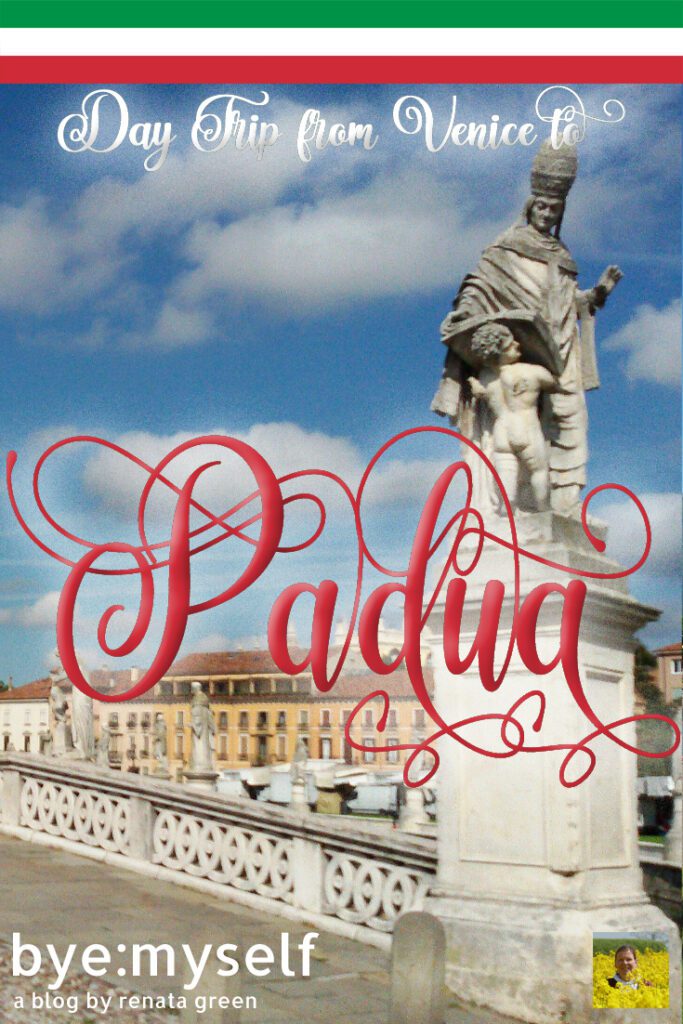





Note: I am completing, editing, and updating this post regularly – last in July 2025.
Did You Enjoy This Post? Then You Might Like Also These:
A Day on MURANO: It’s a Crystalline World
VENICE on a Budget: When to Go, Where to Stay, What to Eat, And Much More
Back to School: Italian Classes at the Scuola Leonardo da Vinci
CINQUE TERRE – The World’s Most Picturesque Hiking Trails
LA SPEZIA and PORTO VENERE – Precious Gems on the Ligurian Coast
Day Trip from Venice to Padua
TIVOLI – Villas, Waters, and Wealth. A Day Trip from Rome
Complete Guide to COMO – a Lake to Like
* This is an affiliate link. If you book through this page, not only do you get the best deal. I also get a small commission that helps me run this blog. Thank you so much for supporting me!

